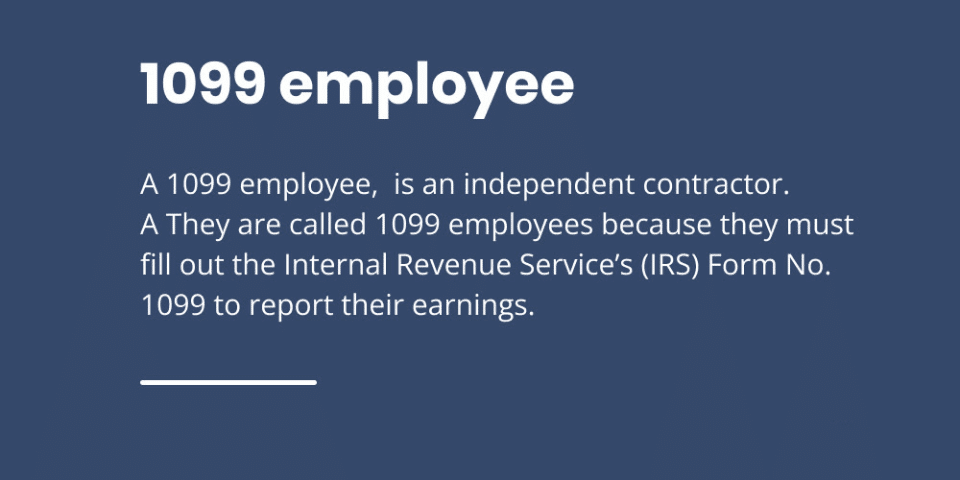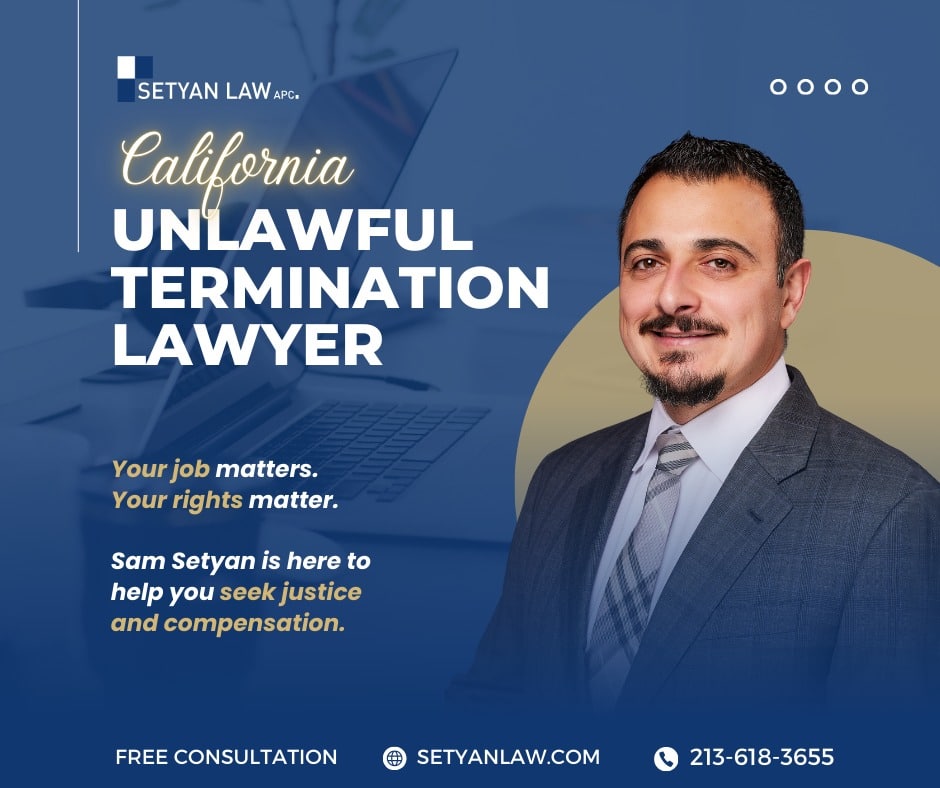Updated March 13, 2025
Can a 1099 Employee Sue for Wrongful Termination in California?
The relationship between employers and independent contractors is complex, often blurring the lines between employee rights and contractual obligations. While traditional employees enjoy a wide array of protections under California labor laws, the situation for 1099 workers is less straightforward. However, recent legal developments and court decisions have begun to reshape the landscape, potentially expanding the rights of independent contractors in certain circumstances.
As we explore this topic, we’ll examine the legal definition of independent contractors in California, the concept of wrongful termination, and the specific scenarios under which a 1099 employee might have grounds for legal action. We’ll also discuss the importance of proper worker classification and the potential consequences of misclassification for both employers and workers.
Whether you’re a 1099 worker concerned about your rights, an employer navigating the complexities of contractor relationships, or simply interested in understanding the evolving landscape of employment law in California, this article aims to provide valuable insights and practical guidance. Let’s dive into the nuanced world of independent contractor rights and wrongful termination in the Golden State.
Even as a 1099 employee, you still have some rights under California law. For instance, you can sue your employer for wrongful termination if they unfairly dismiss you.
Understanding Independent Contractor Status in California
The classification of workers as independent contractors or employees is a critical distinction in California law. This categorization significantly impacts the rights and protections available to workers, as well as the obligations of employers. In recent years, California has implemented stringent tests to determine worker classification, aiming to prevent misclassification and ensure appropriate worker protections.
The ABC Test: California’s Standard for Worker Classification
In 2018, the California Supreme Court introduced the ABC test in the landmark case of Dynamex Operations West, Inc. v. Superior Court. This test has since been codified into law through Assembly Bill 5 (AB5). Under the ABC test, a worker is presumed to be an employee unless the hiring entity can prove all three of the following conditions:
- The worker is free from the control and direction of the hiring entity in connection with the performance of the work, both under the contract for the performance of the work and in fact.
- The worker performs work that is outside the usual course of the hiring entity’s business.
- The worker is customarily engaged in an independently established trade, occupation, or business of the same nature as that involved in the work performed.
This test sets a high bar for classifying workers as independent contractors, reflecting California’s public policy of extending employee protections to a broader range of workers.
Exceptions to the ABC Test
While the ABC test is the primary standard, California law recognizes certain exceptions where alternative tests may apply. These exceptions cover various professions and industries, including:
- Certain licensed professionals (e.g., doctors, lawyers, architects)
- Real estate agents
- Insurance agents
- Certain creative professionals
- Bona fide business-to-business contracting relationships
For these exceptions, the Borello test or other specific criteria may be used to determine worker classification.
The Importance of Proper Classification
Proper classification is crucial for both workers and employers. Misclassification can lead to significant legal and financial consequences, including:
- Liability for unpaid wages and overtime
- Penalties for failure to provide meal and rest breaks
- Fines for non-compliance with labor laws
- Potential class action lawsuits
For workers, misclassification often means being denied essential benefits and protections, such as minimum wage, overtime pay, workers’ compensation, and unemployment insurance.
Recent Developments in California Law
California continues to refine its approach to worker classification. Recent legislation and court decisions have further clarified and, in some cases, expanded the rights of workers traditionally classified as independent contractors. These developments underscore the importance of staying informed about the evolving legal landscape in California employment law.
Understanding the nuances of independent contractor status is the first step in addressing questions of wrongful termination for 1099 workers. As we’ll explore in the following sections, the classification of a worker can significantly impact their ability to pursue legal action in cases of alleged wrongful termination.
Defining Wrongful Termination in California
Wrongful termination is a legal concept that applies when an employer terminates an employee’s contract in violation of employment laws or public policy. In California, understanding wrongful termination is crucial for both employees and employers, as it forms the basis for potential legal action in employment disputes.
At-Will Employment and Its Exceptions
California, like most states, operates under the principle of at-will employment. This means that generally, an employer can terminate an employee for any reason or no reason at all, as long as the reason is not illegal. However, there are important exceptions to this rule:
Breach of Contract: If an employment contract specifies terms for termination, violating these terms can be grounds for a wrongful termination claim.
Discrimination: Terminating an employee based on protected characteristics such as race, gender, age, religion, disability, or sexual orientation is illegal under both California and federal law.
Retaliation: It’s unlawful to terminate an employee for engaging in protected activities, such as reporting illegal activities, filing a workers’ compensation claim, or participating in an investigation.
Public Policy Violations: Terminating an employee for refusing to violate the law or for exercising a legal right (e.g., taking family leave) can be considered wrongful termination.
Whistleblower Protection: California law protects employees who report violations of law to government agencies or persons with authority over the employee.
Constructive Discharge
In some cases, an employee may claim wrongful termination even if they weren’t formally fired. This concept, known as constructive discharge, occurs when an employer makes working conditions so intolerable that a reasonable person would feel compelled to resign.
Wrongful Termination and Public Policy
California recognizes wrongful termination claims based on violations of public policy. This means that even in the absence of a specific statute, terminating an employee for reasons that contravene fundamental public policy principles can be grounds for a lawsuit. Examples include:
- Firing an employee for refusing to commit an illegal act
- Terminating an employee for reporting unsafe working conditions
- Dismissing an employee for serving on jury duty
The Importance of Documentation
In cases of alleged wrongful termination, documentation is crucial. This includes:
- Employment contracts and agreements
- Performance reviews and disciplinary records
- Correspondence related to the termination
- Witness statements or accounts of relevant events
Both employers and employees should maintain thorough records to support their position in the event of a dispute.
Statute of Limitations
It’s important to note that there are time limits for filing wrongful termination claims in California. The statute of limitations varies depending on the specific nature of the claim:
- For most wrongful termination claims: 2 years from the date of termination
- For claims based on written contracts: 4 years
- For claims filed under the Fair Employment and Housing Act (FEHA): 3 years from the date of termination
Understanding these timelines is crucial for preserving one’s right to legal action.
While the concept of wrongful termination is well-established for traditional employees, its application to independent contractors is more complex. In the next section, we’ll explore how these principles may apply to 1099 workers and the unique challenges they face in pursuing wrongful termination claims.
Can Independent Contractors Sue for Wrongful Termination?
The question of whether independent contractors can sue for wrongful termination in California is complex and often depends on the specific circumstances of each case. While traditional employees have clear protections under California labor laws, the situation for independent contractors is less straightforward. However, there are scenarios where 1099 workers may have grounds for legal action.
Limited Protections for Independent Contractors
Generally, independent contractors do not have the same protections against wrongful termination as employees. This is because:
- They are not considered employees under most labor laws.
- Their relationship with the hiring entity is governed primarily by the terms of their contract.
- The concept of "at-will" employment typically doesn’t apply to independent contractors.
However, this doesn’t mean that independent contractors are entirely without recourse in cases of unfair treatment or contract termination.
Potential Grounds for Legal Action
While traditional wrongful termination claims may not be available, independent contractors may have other legal options:
Breach of Contract: If the termination violates the terms of the contract between the contractor and the hiring entity, the contractor may have grounds for a breach of contract lawsuit.
Discrimination Claims: California law prohibits discrimination against independent contractors based on protected characteristics. If a contract is terminated due to discrimination, the contractor may have a valid legal claim.
Retaliation: In some cases, independent contractors may be protected from retaliation for reporting illegal activities or unsafe conditions.
Misclassification: If an independent contractor believes they have been misclassified and should actually be considered an employee, they may be able to pursue a wrongful termination claim after establishing their employee status.
The ABC Test and Its Impact
California’s ABC test, as discussed earlier, has significant implications for independent contractor rights. If a worker can demonstrate that they have been misclassified under this test, they may be entitled to the same protections as employees, including the right to sue for wrongful termination.
Recent Legal Developments
Recent court decisions and legislative changes in California have expanded protections for some workers traditionally classified as independent contractors. For example:
- The California Supreme Court’s decision in Dynamex Operations West, Inc. v. Superior Court (2018) made it more difficult for companies to classify workers as independent contractors.
- Assembly Bill 5 (AB5), which went into effect in 2020, codified the ABC test and expanded employee classification to many workers previously considered independent contractors.
These developments have increased the potential for some 1099 workers to challenge their classification and, by extension, pursue claims similar to those available to employees.
Challenges in Pursuing Legal Action
Independent contractors face several challenges when considering legal action for wrongful termination:
- Proving Employee Status: To access employee protections, a contractor may need to first prove they were misclassified.
- Contract Terms: The specific terms of the contract may limit the contractor’s rights or specify conditions for termination.
- Burden of Proof: In breach of contract cases, the contractor must prove that the termination violated the contract terms.
- Limited Damages: Even if successful, the damages available to independent contractors may be more limited than those available to employees.
Seeking Legal Advice
Given the complexities of these cases, independent contractors who believe they have been wrongfully terminated should seek advice from an experienced employment attorney. An attorney can help:
- Evaluate the specific circumstances of the case
- Determine if there are grounds for legal action
- Assess whether the worker may have been misclassified
- Navigate the legal process and protect the worker’s rights
While the path to legal recourse for wrongful termination may be more challenging for independent contractors, it’s not impossible. Understanding one’s rights, the terms of the contract, and the evolving legal landscape in California is crucial for 1099 workers facing unfair treatment or contract termination.
Misclassification: A Key Issue in Independent Contractor Rights
Misclassification of workers as independent contractors when they should be classified as employees is a significant issue in California employment law. This practice not only affects workers’ rights and benefits but also has implications for potential wrongful termination claims. Understanding misclassification is crucial for both workers and employers in navigating the complex landscape of employment relationships.
The Prevalence of Misclassification
Misclassification occurs when employers incorrectly label workers as independent contractors instead of employees. This practice is often motivated by:
- Reduced costs for employers (e.g., avoiding payroll taxes, benefits, overtime pay)
- Increased flexibility in workforce management
- Avoidance of certain labor law obligations
However, misclassification can have serious legal and financial consequences for employers and significantly impact workers’ rights and protections.
Consequences of Misclassification
For workers, being misclassified as an independent contractor can mean:
- Loss of employee benefits (health insurance, retirement plans, etc.)
- No protection under many labor laws (minimum wage, overtime, etc.)
- Ineligibility for unemployment insurance and workers’ compensation
- Responsibility for self-employment taxes
For employers, the consequences of misclassification can include:
- Substantial fines and penalties from state and federal agencies
- Liability for unpaid wages, overtime, and benefits
- Potential class action lawsuits
- Reputational damage
California’s Efforts to Combat Misclassification
California has taken significant steps to address worker misclassification:
The ABC Test: As previously discussed, this test sets a high bar for classifying workers as independent contractors.
Assembly Bill 5 (AB5): This law codified the ABC test and expanded its application across industries, with some exceptions.
Enforcement Actions: California labor agencies have increased enforcement efforts against companies suspected of misclassification.
Penalties: The state has implemented strict penalties for willful misclassification, including fines of $5,000 to $25,000 per violation.
Impact on Wrongful Termination Claims
Misclassification can significantly impact a worker’s ability to pursue a wrongful termination claim:
Reclassification as an Employee: If a worker can prove they were misclassified, they may gain access to employee protections, including the right to sue for wrongful termination.
Retroactive Benefits: In cases of misclassification, workers may be entitled to retroactive benefits and protections, potentially strengthening their position in a wrongful termination case.
Expanded Legal Options: Reclassification can open up additional legal avenues beyond breach of contract claims, such as violations of labor laws or discrimination statutes.
Challenging Misclassification
Workers who believe they have been misclassified can take several steps:
Review the Working Relationship: Assess factors like degree of control, integration into the business, and economic dependence on the employer.
Document the Work Arrangement: Keep records of work performed, hours worked, and communications with the employer.
Consult with an Attorney: An experienced employment lawyer can evaluate the situation and advise on potential legal action.
File a Complaint: Workers can file complaints with state labor agencies or the Internal Revenue Service (IRS).
The Role of Courts and Agencies
California courts and labor agencies play a crucial role in addressing misclassification:
Court Decisions: Recent court rulings have clarified and sometimes expanded the definition of "employee" in various contexts.
Agency Investigations: State agencies like the Labor Commissioner’s Office actively investigate and penalize instances of misclassification.
Legislative Updates: The California legislature continues to refine laws addressing worker classification, often in response to court decisions and changing economic realities.
Understanding misclassification is essential for both workers and employers in California. For 1099 workers considering legal action for wrongful termination, addressing potential misclassification can be a critical first step in accessing employee protections and rights. As California continues to lead the way in addressing this issue, staying informed about legal developments and seeking professional advice when needed is crucial for navigating this complex area of employment law.
Legal Options for 1099 Workers Facing Unfair Termination
While traditional wrongful termination claims may be challenging for independent contractors, 1099 workers in California do have legal options if they believe they’ve been unfairly terminated. Understanding these options is crucial for protecting one’s rights and pursuing appropriate recourse.
1. Breach of Contract Claims
The primary legal avenue for independent contractors is often a breach of contract claim:
- Contract Terms: Review the contract for specific termination clauses or conditions that may have been violated.
- Implied Contracts: Even without a written agreement, implied contracts based on verbal agreements or established practices may be enforceable.
- Damages: Potential damages may include lost earnings for the remainder of the contract term or other financial losses directly resulting from the breach.
2. Discrimination and Retaliation Claims
California law prohibits discrimination and retaliation against independent contractors:
- Protected Characteristics: Claims can be based on discrimination due to race, gender, age, disability, religion, or other protected characteristics.
- Retaliation Protection: Contractors who report illegal activities or unsafe conditions may be protected from retaliatory termination.
- Filing Process: These claims typically involve filing a complaint with the California Department of Fair Employment and Housing (DFEH) before pursuing a lawsuit.
3. Misclassification Challenges
If a worker believes they’ve been misclassified as an independent contractor:
- File a Claim: Workers can file a wage claim with the California Labor Commissioner’s Office.
- Seek Reclassification: Successfully challenging misclassification can open up additional legal protections and remedies.
- Retroactive Benefits: If reclassified, workers may be entitled to retroactive employee benefits and protections.
4. Public Policy Violation Claims
In some cases, independent contractors may have claims based on violations of public policy:
- Whistleblower Protections: California law protects workers, including some contractors, who report illegal activities.
- Refusal to Perform Illegal Acts: Termination for refusing to engage in illegal activities may be grounds for a claim.
- Exercise of Legal Rights: Contractors terminated for exercising legal rights (e.g., filing a workers’ compensation claim) may have recourse.
5. Unfair Business Practices Claims
Under California’s Unfair Competition Law:
- Broad Protections: This law provides broad protections against unfair, unlawful, or fraudulent business practices.
- Potential Remedies: While monetary damages are limited, injunctive relief and restitution may be available.
6. Tort Claims
In certain circumstances, independent contractors may have grounds for tort claims:
- Fraud: If the termination involved fraudulent representations or actions by the hiring entity.
- Intentional Interference: If a third party intentionally interfered with the contractual relationship, leading to termination.
7. Negotiation and Alternative Dispute Resolution
Before or alongside legal action, consider:
- Direct Negotiation: Attempt to resolve the issue directly with the hiring entity.
- Mediation: A neutral third party can help facilitate a resolution.
- Arbitration: If specified in the contract, arbitration may be required before litigation.
Steps to Take When Considering Legal Action
Document Everything: Keep detailed records of all communications, work performed, and circumstances surrounding the termination.
Review the Contract: Carefully examine the terms of your agreement, including any dispute resolution procedures.
Assess Classification: Consider whether you may have been misclassified as an independent contractor.
Consult an Attorney: An experienced employment lawyer can evaluate your case and advise on the best course of action.
Be Aware of Deadlines: Understand the statutes of limitations for various types of claims to ensure you don’t lose your right to legal action.
Consider the Costs: Weigh the potential benefits of legal action against the costs and time involved.
Challenges and Considerations
While legal options exist, 1099 workers face unique challenges:
- Burden of Proof: The contractor often bears the burden of proving contract violations or unfair treatment.
- Limited Protections: Many employment laws don’t apply directly to independent contractors.
- Contractual Limitations: Some contracts may include clauses limiting legal recourse or requiring specific dispute resolution methods.
The Evolving Legal Landscape
California’s laws regarding independent contractors continue to evolve:
- New Legislation: Stay informed about new laws that may affect contractor rights and classification.
- Court Decisions: Recent court rulings may expand or clarify the rights of 1099 workers.
- Industry-Specific Changes: Some industries may see targeted legislation affecting contractor relationships.
While the path to legal recourse for 1099 workers facing unfair termination can be complex, options do exist. By understanding these options, documenting the situation carefully, and seeking professional legal advice, independent contractors can take informed steps to protect their rights and interests in the face of unfair treatment or contract termination.
Preventive Measures for Independent Contractors
For independent contractors in California, taking proactive steps to protect their rights and interests is crucial. By implementing preventive measures, 1099 workers can reduce the risk of unfair treatment and strengthen their position in case of disputes or termination. Here are key strategies for independent contractors to consider:
1. Comprehensive Contract Drafting and Review
A well-drafted contract is your first line of defense:
- Clear Terms: Ensure the contract clearly outlines the scope of work, payment terms, and conditions for termination.
- Dispute Resolution: Include provisions for how disputes will be handled, including potential mediation or arbitration clauses.
- Legal Review: Consider having an attorney review your contract before signing.
- Negotiation: Don’t hesitate to negotiate terms that protect your interests.
2. Maintain Clear Documentation
Thorough record-keeping is essential:
- Work Performed: Keep detailed logs of all work completed, hours worked, and deliverables.
- Communications: Save all emails, texts, and other communications with the hiring entity.
- Payments: Maintain accurate records of all payments received and invoices sent.
- Performance Feedback: Document any feedback or performance reviews received.
3. Understand Your Classification
Be proactive about your worker classification:
- Self-Assessment: Regularly assess whether your working relationship aligns with independent contractor status under California law.
- Stay Informed: Keep up-to-date with changes in California labor laws regarding worker classification.
- Seek Clarification: If unsure about your status, seek clarification from the hiring entity or consult with a legal professional.
4. Maintain Professional Independence
Reinforce your status as an independent contractor:
- Multiple Clients: When possible, work for multiple clients to demonstrate independence.
- Business Structure: Consider forming a business entity (LLC, S-Corp) to further establish your independent status.
- Professional Development: Invest in your own training and tools to show self-reliance.
5. Regular Communication and Performance Reviews
Maintain open lines of communication:
- Regular Check-ins: Schedule periodic reviews with the hiring entity to discuss performance and expectations.
- Address Issues Promptly: Don’t let small issues escalate; address concerns as they arise.
- Document Discussions: Keep records of all performance-related discussions and agreements.
6. Understand Your Rights
Knowledge is power:
- Anti-Discrimination Laws: Familiarize yourself with California’s anti-discrimination protections for independent contractors.
- Whistleblower Protections: Understand your rights if you need to report illegal activities or safety concerns.
- Industry-Specific Regulations: Be aware of any regulations specific to your industry that may affect your rights.
7. Build a Professional Network
Networking can provide support and opportunities:
- Professional Associations: Join industry associations or contractor groups for support and resources.
- Legal Connections: Establish a relationship with an employment attorney before issues arise.
- Peer Support: Connect with other independent contractors to share experiences and advice.
8. Financial Planning and Insurance
Protect yourself financially:
- Emergency Fund: Maintain savings to cover periods between contracts or potential legal expenses.
- Professional Liability Insurance: Consider obtaining insurance to protect against potential claims.
- Health and Disability Insurance: Secure personal insurance coverage to fill gaps left by not having employee benefits.
9. Continuous Professional Development
Enhance your value and independence:
- Skills Upgrade: Regularly update your skills to maintain competitiveness.
- Industry Trends: Stay informed about developments in your field.
- Certifications: Obtain relevant certifications to enhance your professional standing.
10. Establish Clear Boundaries
Maintain a clear distinction between your work and that of employees:
- Work Environment: When possible, use your own equipment and work space.
- Schedule Flexibility: Exercise control over your work schedule when appropriate.
- Project Focus: Focus on delivering agreed-upon results rather than adhering to company processes.
11. Exit Strategy Planning
Be prepared for contract termination:
- Notice Periods: Understand and plan for the notice periods specified in your contract.
- Transition Planning: Have a plan for transitioning work or finding new opportunities.
- Intellectual Property: Be clear on ownership of work products and any non-compete clauses.
12. Regular Contract Reviews
Periodically reassess your contractual relationships:
- Annual Review: At least annually, review your contracts and working relationships.
- Renegotiation: Be prepared to renegotiate terms as your business or the market changes.
- Exit Clauses: Understand and potentially negotiate favorable exit clauses.
By implementing these preventive measures, independent contractors in California can create a more secure working environment and be better prepared to handle potential disputes or termination scenarios. While these strategies can’t guarantee protection against all issues, they significantly strengthen a contractor’s position and provide a solid foundation for maintaining successful and legally compliant business relationships.
The Future of Independent Contractor Rights in California
The landscape of independent contractor rights in California is dynamic and continually evolving. As the gig economy expands and new forms of work emerge, legislators, courts, and labor advocates are grappling with how to balance worker protections with the flexibility that many contractors value. Understanding the current trends and potential future developments is crucial for both independent contractors and the entities that hire them.
Current Trends Shaping the Future
Expansion of Worker Protections:
- California continues to lead the nation in expanding protections for workers, including those traditionally classified as independent contractors.
- Recent legislation like AB5 and subsequent amendments reflect ongoing efforts to redefine worker classifications.
Industry-Specific Regulations:
- Different industries are seeing tailored approaches to worker classification and rights.
- The ride-sharing and delivery service sectors, in particular, have been at the forefront of these changes.
Increased Scrutiny of Worker Classification:
- State agencies are intensifying efforts to identify and penalize misclassification.
- This increased scrutiny is likely to continue, pushing companies to reassess their contractor relationships.
Technological Impact:
- The rise of remote work and digital platforms is blurring traditional lines between employees and contractors.
- New technologies are creating novel work arrangements that challenge existing legal frameworks.
Potential Future Developments
Further Legislative Action:
- California may continue to refine and expand laws governing independent contractor relationships.
- There may be efforts to create new categories of workers that bridge the gap between traditional employees and contractors.
Court Decisions Shaping Policy:
- Future court rulings, especially at the state Supreme Court level, could significantly impact contractor rights and classifications.
- These decisions may lead to new interpretations of existing laws or prompt legislative responses.
Federal-State Interactions:
- Changes in federal labor laws or policies could influence California’s approach to independent contractor rights.
- Potential conflicts between state and federal regulations may need to be resolved.
Expansion of Benefits for Contractors:
- There may be moves to extend certain benefits traditionally reserved for employees (e.g., unemployment insurance, workers’ compensation) to some categories of independent contractors.
Portable Benefits Systems:
- Discussions around creating portable benefit systems that move with workers across different gigs or contracts may gain traction.
Increased Focus on Specific Industries:
- Certain sectors, such as technology, healthcare, and creative industries, may see targeted regulations addressing their unique contractor relationships.
Enhanced Enforcement Mechanisms:
- State agencies may develop more sophisticated tools and processes for identifying and addressing worker misclassification.
Alternative Dispute Resolution:
- There may be a push for more efficient and accessible dispute resolution mechanisms for contractor-related conflicts.
Challenges and Opportunities
Balancing Flexibility and Protection:
- Finding the right balance between worker protections and the flexibility valued by many contractors remains a key challenge.
Adapting to Technological Changes:
- The law will need to keep pace with rapidly evolving work arrangements enabled by technology.
Economic Impacts:
- Changes in contractor regulations can have significant economic impacts, affecting business models and job markets.
Cross-Border Considerations:
- With the rise of remote work, addressing contractor rights across state and national borders will become increasingly important.
Education and Compliance:
- Both contractors and hiring entities will need to stay informed and adapt to changing regulations.
Preparing for the Future
For independent contractors:
- Stay informed about legal changes affecting your industry.
- Be proactive in understanding and asserting your rights.
- Consider joining professional associations or advocacy groups focused on contractor issues.
- Regularly reassess your working relationships and contracts in light of evolving laws.
For businesses hiring contractors:
- Regularly review and update contractor agreements and relationships.
- Stay ahead of regulatory changes by monitoring legislative developments.
- Consider developing flexible work arrangements that comply with evolving standards.
- Invest in proper classification processes and documentation.
The Role of Advocacy and Public Policy
- Worker advocacy groups and industry associations will likely play a significant role in shaping future policies.
- Public debate and stakeholder input will be crucial in developing balanced and effective regulations.
The future of independent contractor rights in California is likely to be characterized by ongoing change and adaptation. As the nature of work continues to evolve, so too will the legal and regulatory framework governing contractor relationships. Staying informed, adaptable, and proactive will be key for both independent contractors and the entities that engage them to navigate this dynamic landscape successfully.
Conclusion: Navigating the Complex Landscape of Independent Contractor Rights
As we’ve explored throughout this comprehensive guide, the question of whether a 1099 employee can sue for wrongful termination in California is nuanced and complex. While traditional employees enjoy clear protections under California labor laws, the situation for independent contractors is more challenging but not without recourse.
Key takeaways include:
Classification is Crucial: The distinction between employees and independent contractors is fundamental to determining available legal protections. California’s ABC test and recent legislation like AB5 have made worker classification a central issue in employment law.
Limited but Existing Rights: While independent contractors don’t have the same broad protections as employees, they do have rights under contract law, anti-discrimination statutes, and in cases of misclassification.
Potential for Legal Action: Depending on the circumstances, 1099 workers may have grounds for legal action based on breach of contract, discrimination, retaliation, or misclassification.
Evolving Legal Landscape: California continues to be at the forefront of expanding worker protections, with ongoing legislative and judicial developments shaping the rights of independent contractors.
Importance of Documentation: For both contractors and hiring entities, maintaining clear contracts, thorough documentation, and open communication is crucial in preventing and addressing disputes.
Preventive Measures: Taking proactive steps, such as careful contract drafting, understanding one’s rights, and maintaining professional independence, can significantly strengthen an independent contractor’s position.
Future Trends: The gig economy, technological advancements, and changing work patterns are likely to continue influencing the evolution of contractor rights and regulations.
For 1099 workers facing potential wrongful termination or unfair treatment, it’s essential to:
- Carefully review the terms of your contract and working relationship
- Document all relevant communications and work performed
- Consider whether misclassification may be an issue
- Understand the various legal options available, from breach of contract claims to discrimination complaints
- Seek professional legal advice to evaluate your specific situation and determine the best course of action
For businesses engaging independent contractors, it’s crucial to:
- Stay informed about current laws and regulations regarding worker classification
- Regularly review and update contractor agreements
- Implement clear policies and practices that respect contractor independence
- Be prepared to adapt to evolving legal standards and workforce trends
As California continues to lead the way in addressing worker rights and protections, the landscape for independent contractors will likely see further changes. Both 1099 workers and the entities that engage them must stay informed, adaptable, and proactive in navigating this complex and evolving area of employment law.
Ultimately, while the path to legal recourse for wrongful termination may be more challenging for independent contractors compared to traditional employees, it is not insurmountable. By understanding their rights, maintaining clear documentation, and seeking appropriate legal guidance when needed, 1099 workers in California can better protect their interests and pursue fair treatment in their professional relationships.
Remember, you are not alone in this journey. Many employees have successfully challenged unfair dismissals and secured justice. By arming yourself with knowledge, seeking appropriate legal guidance, and taking strategic action, you can stand up for your rights and work towards a positive resolution.
Wrongful termination cases are often complex, and outcomes can vary widely based on individual circumstances. However, by understanding your rights and the legal landscape, you’re better equipped to make informed decisions and take appropriate action. Whether your next step is consulting with an attorney, filing a complaint, or negotiating with your former employer, approach it with confidence, knowing that you’re taking proactive steps to protect your rights and your future.
Your career is more than just a job—it’s a significant part of your life and identity. By standing up against wrongful termination, you’re not only fighting for your own rights but also contributing to a fairer workplace for all employees. Stay resilient, stay informed, and remember that with the right approach and support, you can overcome this challenge and move forward towards a brighter professional future.
If you’re employed by a California employer, contact an expert Wrongful Termination Attorney first, for expert assistance regarding your case. Call today for a free and confidential consultation.







